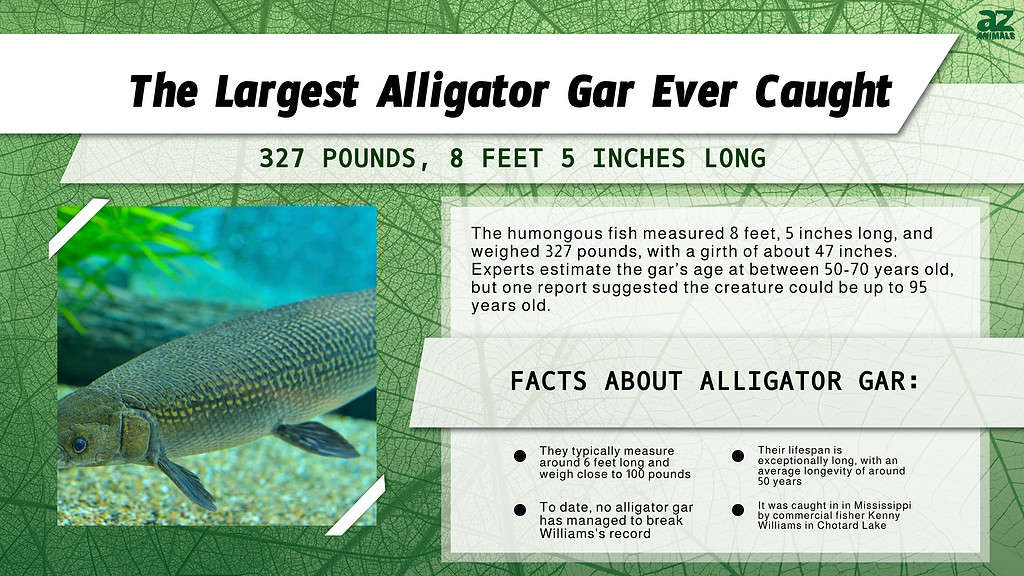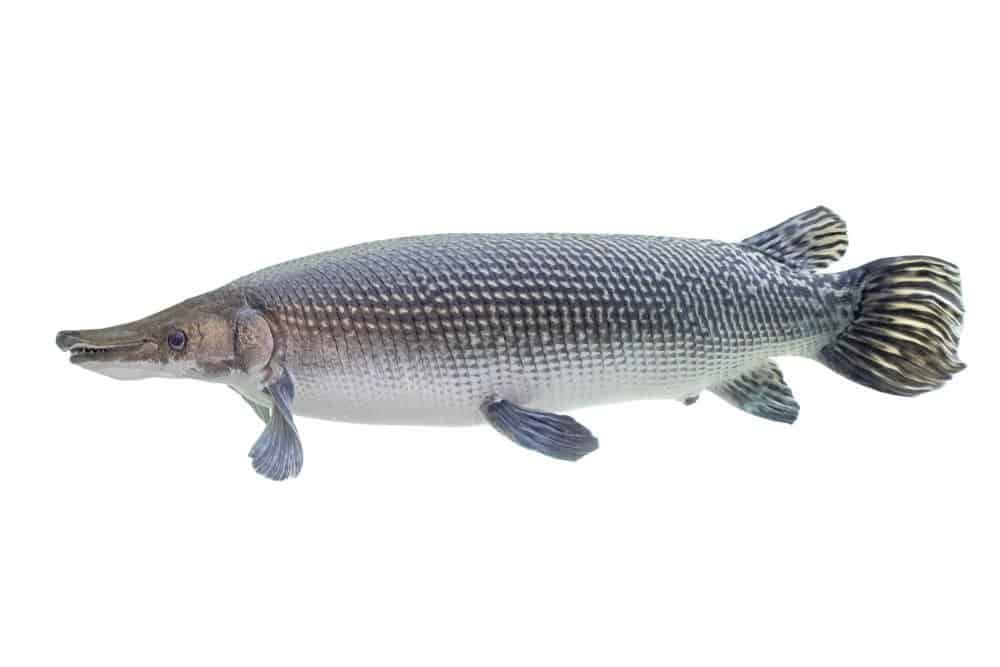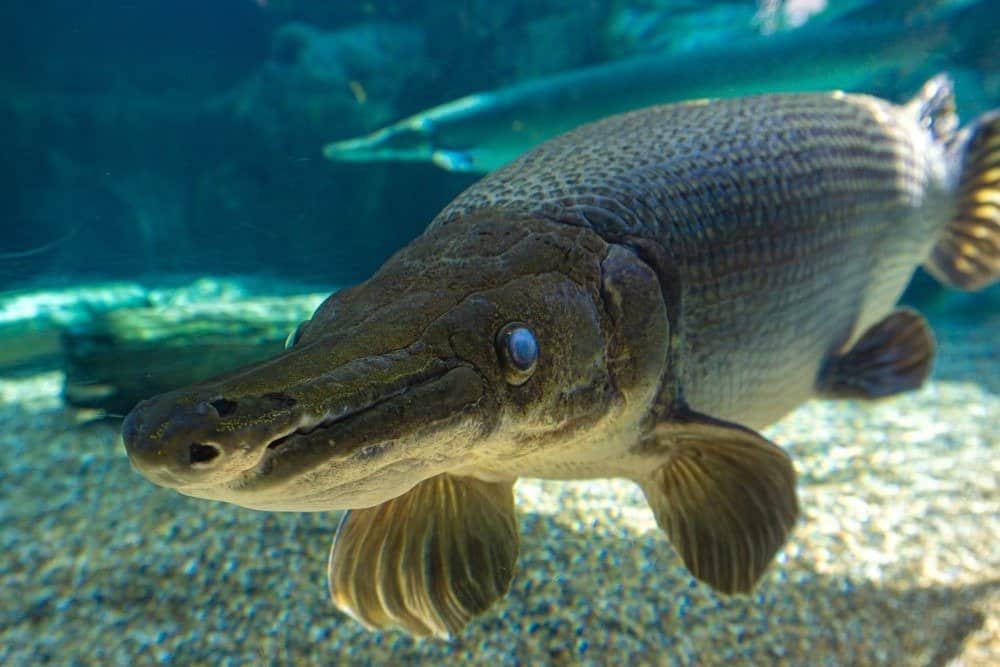The alligator gar is a ray-finned euryhaline fish related to the bowfin. The alligator gar is also a living legend! Over 100 million years, this “primitive fish” evolved into a voracious ambush predator. It is the largest member of the gar family and one of the biggest freshwater fish found in North America. Belonging to the Holostei class of ray-finned fish, these bony marine monsters are the ultimate survivalists. They are capable of living in environments where most fish would quickly suffocate and die. While they may appear horrifying, serve an important ecological function, making them worthy of protection and deserving of admiration.
So, what is the biggest alligator gar ever caught? Well, we have an update for one of the biggest specimens reeled in! In October 2021, an angler on the Neosho River pulled up a catch he was least expecting: a 4.5 ft, 39.5 lb alligator gar. This “living fossil fish” was a shocking catch because it was a first, as these fish are not native to Kansas rivers but are found in parts of Ohio, Illinois, the Mississippi River Basin, and south of the Gulf of Mexico. While a record-breaking find, the Fish and Wildlife Department is concerned due to the possible introduction of invasive species or diseases to native fish populations by this non-native fish. Another question is how did the alligator gar end up in there in the first place? Thoughts are it was dumped there by an aquarium or someone who could no longer keep it as a pet. However, the Department is worried that a water source may be contributing. Biologists are attempting to determine the fish’s origin through genetic identification markers and microchemistry tests.
For years, fishers viewed alligator gar as “trash fish.” Anglers would slaughter them en masse in an effort to protect game fish populations. However, over the past few decades, this perception slowly changed to the point that now fishers view alligator gar as prime trophies. From time to time, fishers will encounter monstrous alligator gar that makes their generally large kin seem tiny in comparison. While sometimes caught on accident, others found themselves on the end of a trophy hunter’s hook or arrow.
Let’s dive into a look at the largest alligator gar on record, and how these incredible fish have survived for over 100 million years.
Built to Survive

The alligator gar (
Atractosteus spatula) is a ray-finned euryhaline fish related to the bowfin in the infraclass Holostei.
©tristan tan/Shutterstock.com
Shaped like a torpedo, the alligator gar’s olive-green body bears an uncanny resemblance to the American alligator, with whom it shares a name. Their long, broad snouts look just like an alligator’s and are just as dangerous. They possess two rows of teeth along their upper jaw, which enables them to effectively prevent their prey from escaping their clutches. Serrated ganoid scales made of bone-hard dentine cover their bodies from head to tail, making them almost impregnable.
Alligator gar typically measures around 6 feet long and weighs close to 100 pounds. However, they grow exceptionally slowly, and it takes years for them to sexually mature. As a result, their lifespan is exceptionally long, with an average longevity of around 50 years. In addition, the older the fish, the more likely it is to reach an unnatural size. Their long lifespan implies that older specimens may measure significantly larger than their younger kin.
As euryhaline fish, alligator gar can live in varied habitats, from freshwater lakes to brackish swamps to salt-water estuaries near the coast. In addition, while they have gills, they also evolved a vascular swim bladder lung. This quirky adaptation allows them to breathe in and out of the water. The alligator gar is an armored tank with teeth, designed to not just survive but thrive in any environment it calls home.
Masters of Ambush Tactics

Alligator gars spend the majority of their time floating under the surface of the water waiting for prey.
©Cheng Wei/Shutterstock.com
At first glance, the alligator gar does not seem like a highly adaptable killing machine. They spend most of their time floating just beneath the surface of the water and rarely move with urgency. In reality, their sluggish act is a mere facade that obscures their brutal power. Alligator gar are opportunistic hunters and more than willing to wait for oblivious prey to wander too close. Once their prey is in striking distance, they will lunge forward, grab on, and not let go.
Although primarily piscivores, alligator gar will eat almost anything they can catch. This includes turtles, small mammals, crabs, and waterfowl. Furthermore, since they are not picky eaters, they have no qualms about scavenging for food. They hunt at night, and it’s their nocturnal habits that make it difficult to get an accurate reading of how large they can grow in the wild. Luckily, some records of giant alligator gar exist which provide an estimate as to just how large they can get if left unchecked.

Record-Setting Catches

Texas and Mississippi are the best states to find large alligator gars.
©TheSoon/Shutterstock.com
Alligator gar occurs throughout the southern United States. They can be found in Oklahoma, Kentucky, Alabama, Tennessee, Missouri, Georgia, Florida, Arkansas, Mississippi, Louisiana, and Texas. In addition, their range extends south into Mexico as far as Veracruz. Of these regions, Texas and Mississippi rank among the best locations to find huge alligator gar. Several record-setting fish originated in the state’s waters, and each deserves mentioning as we uncover which specimen is the largest of them all.
The largest alligator gar ever caught on rod and reel was taken by World War II veteran Guillermo “Bill” Valverde of Mission, Texas. On January 1, 1951, Bill hiked to a local fishing spot on the Rio Grande River with his father, Trinidad, and friend Rev. Josue Gonzalez. While the three set their eyes on snagging some catfish, they instead caught four large gars in a row. Each of these first specimens measured around 100 pounds. Then, they snagged a huge gar measuring 7 feet, 9 inches tall, and weighing 289 pounds. To this day, it remains the largest freshwater fish and alligator gar caught on rod and reel in Texas.
Meanwhile, the largest bow-fishing record for alligator gar measured even bigger than Bill’s rod-and-reel specimen. In 2001, angler Marty McClellan shot an alligator gar measuring 8 feet long and weighing 290 pounds. He shot the gar on the Trinity River in Texas, which has been the source of many exceptionally sized fish over the years. For example, fishing guide Kirk Kirkland claims that he caught an alligator gar from the Trinity River measuring 9 feet, 6 inches long on rod and line back in 1991. While the claim was never verified, such a fish would certainly count among the largest gar ever recorded.
World Record Catch

The biggest alligator gar catch on record weighed 327 pounds.
©TKBackyard/Shutterstock.com
The largest alligator gar ever caught weighed 327 pounds and was captured in 2001.
However, it wasn’t caught in Texas, but rather in Mississippi, and it happened completely by accident. On February 14, 2001, Vicksburg commercial fisher Kenny Williams was preparing to wrap up for the day. It was Valentine’s Day, and he had just finished bringing in a haul of buffalo fish. As he was pulling up his last net from the waters of Chotard Lake, his net caught on something. Thinking the net merely snagged on a log, Williams pulled up the net, but to his surprise, tangled in the net lay a massive alligator gar.
The fish was barely alive at that point, but Williams still struggled to drag the giant creature into his 16-foot aluminum boat. It took him nearly 30 minutes to drag the fish on board, officially cementing his claim as the largest alligator gar ever caught. The humongous fish measured 8 feet, 5 inches long, and weighed 327 pounds, with a girth of about 47 inches. Experts estimate the gar’s age at between 50-70 years old, but one report suggested the creature could be up to 95 years old.
To date, no alligator gar has managed to break Williams’s record. However, that doesn’t mean that there isn’t a giant fish out there, lurking in the shadows, just waiting to be spotted by some intrepid naturalist or lucky angler.
Where Is Chotard Lake Located on a Map?
Chotard Lake is situated in Issaquena County, Mississippi. It is near the hamlets of Bellevue and Brunswick. The lake is around 18 miles from Vicksburg and about 13 miles north of Eagle Lake.
The photo featured at the top of this post is © TKBackyard/Shutterstock.com
FAQs (Frequently Asked Questions)
What was the largest alligator gar ever caught in Texas?
The record alligator gar in Texas was caught in 1951 and weighed 289 pounds.
What was the largest alligator gar ever caught in Louisiana?
The largest alligator gar caught in Louisiana was a 215 pound gar captured in 2002. However, the record setting gar is ineligible for record books since it was captured with a bow. The official record remains a 179 pound gar captured in 1997.
Thank you for reading! Have some feedback for us? Contact the AZ Animals editorial team.






